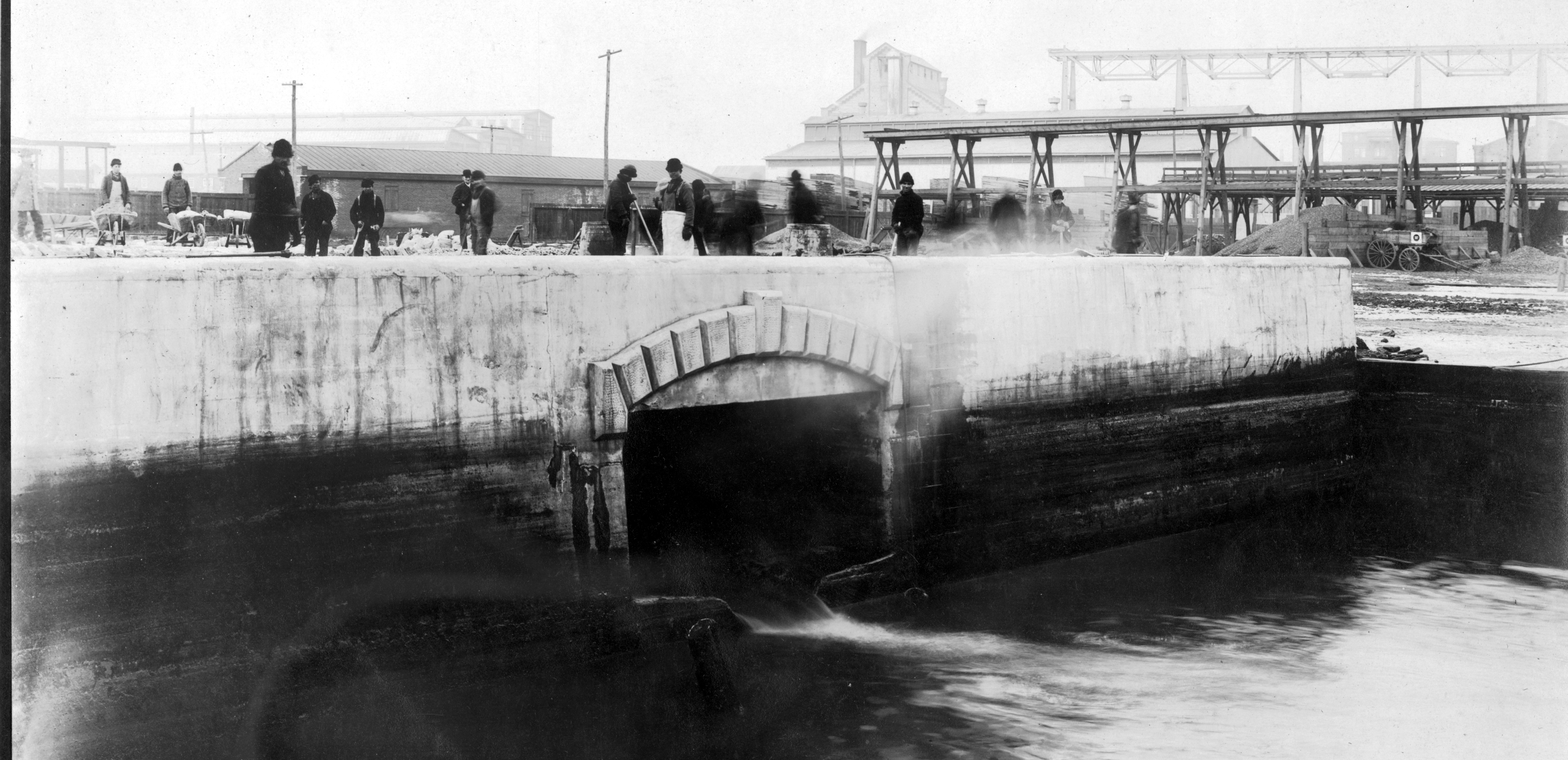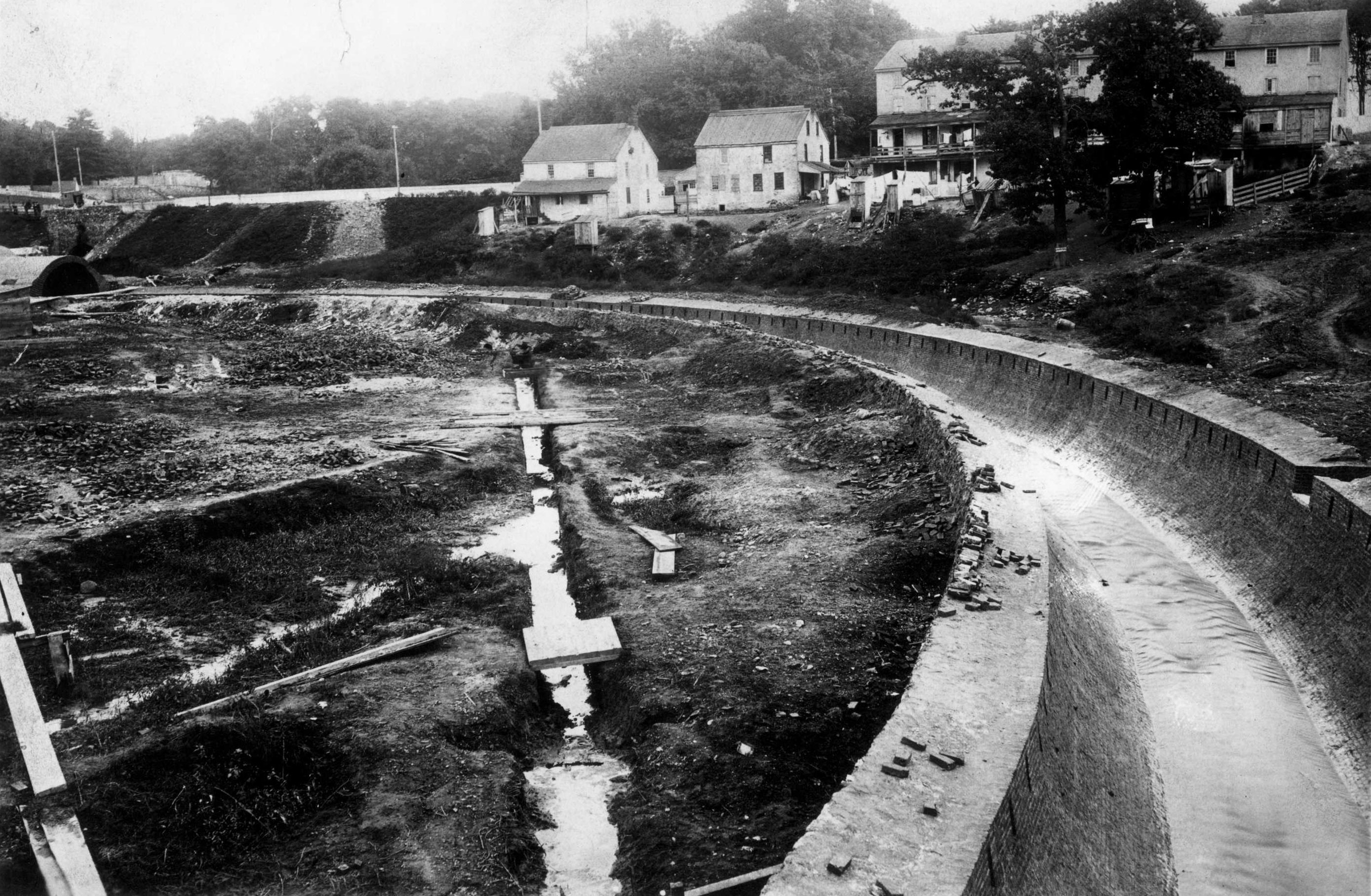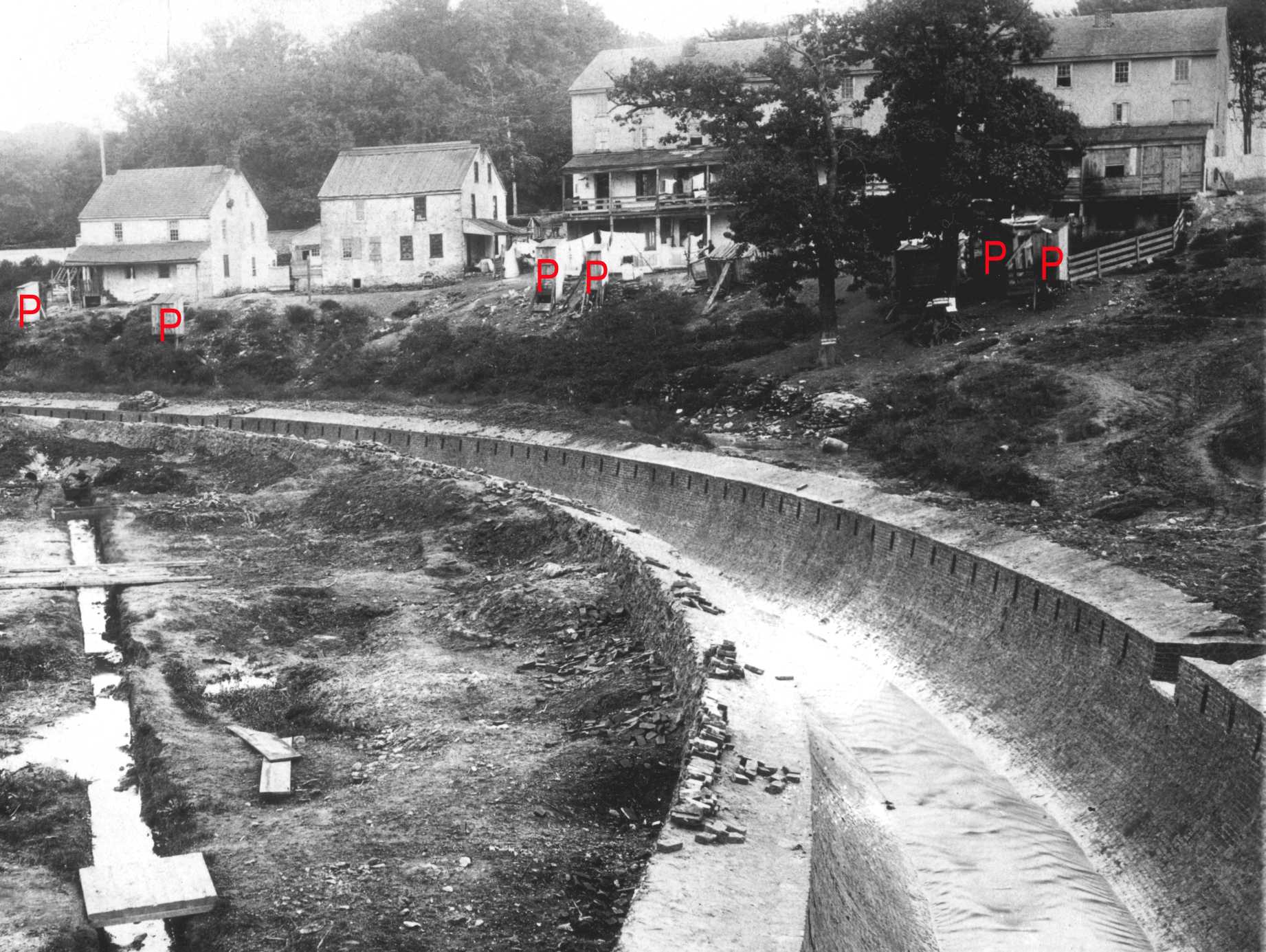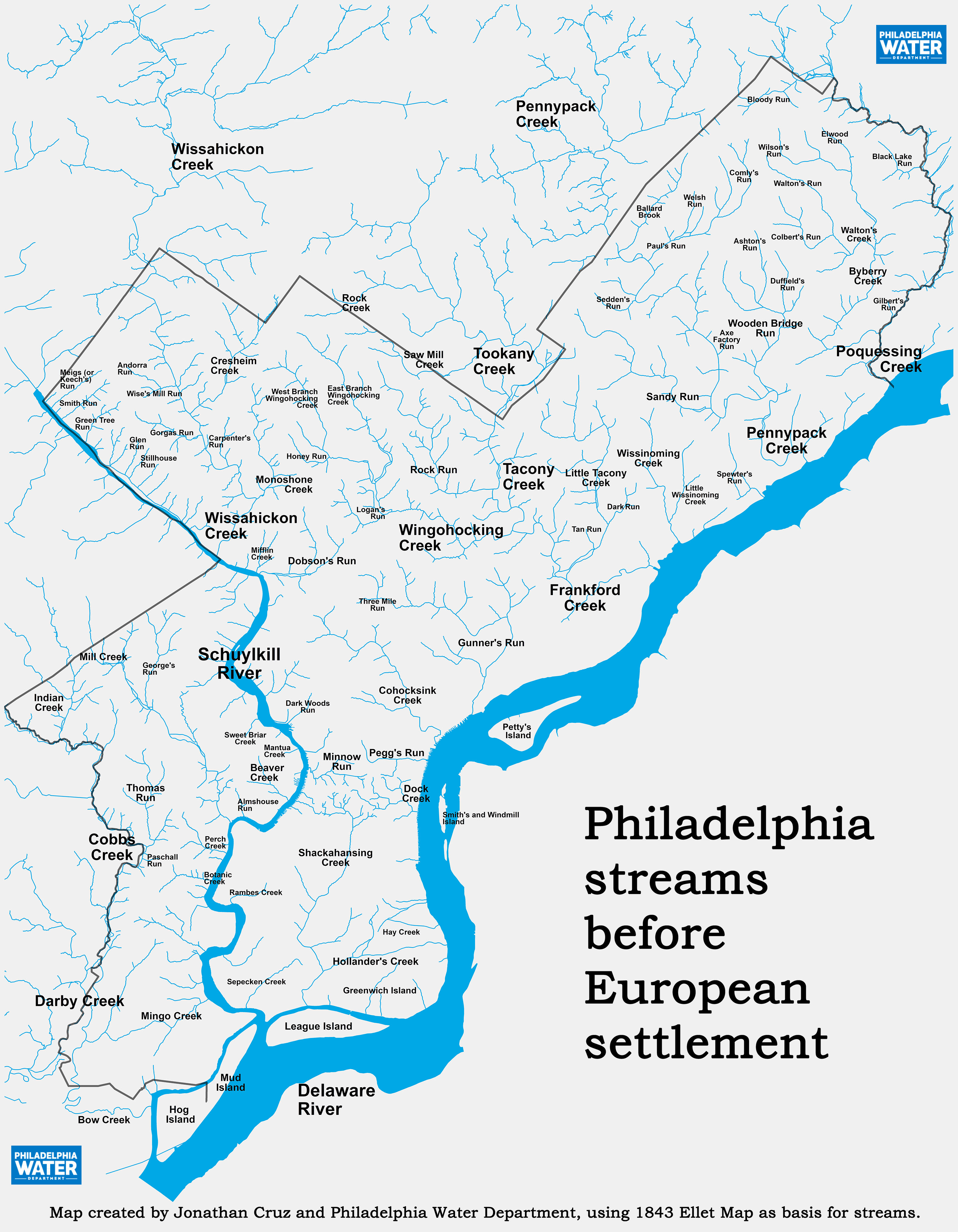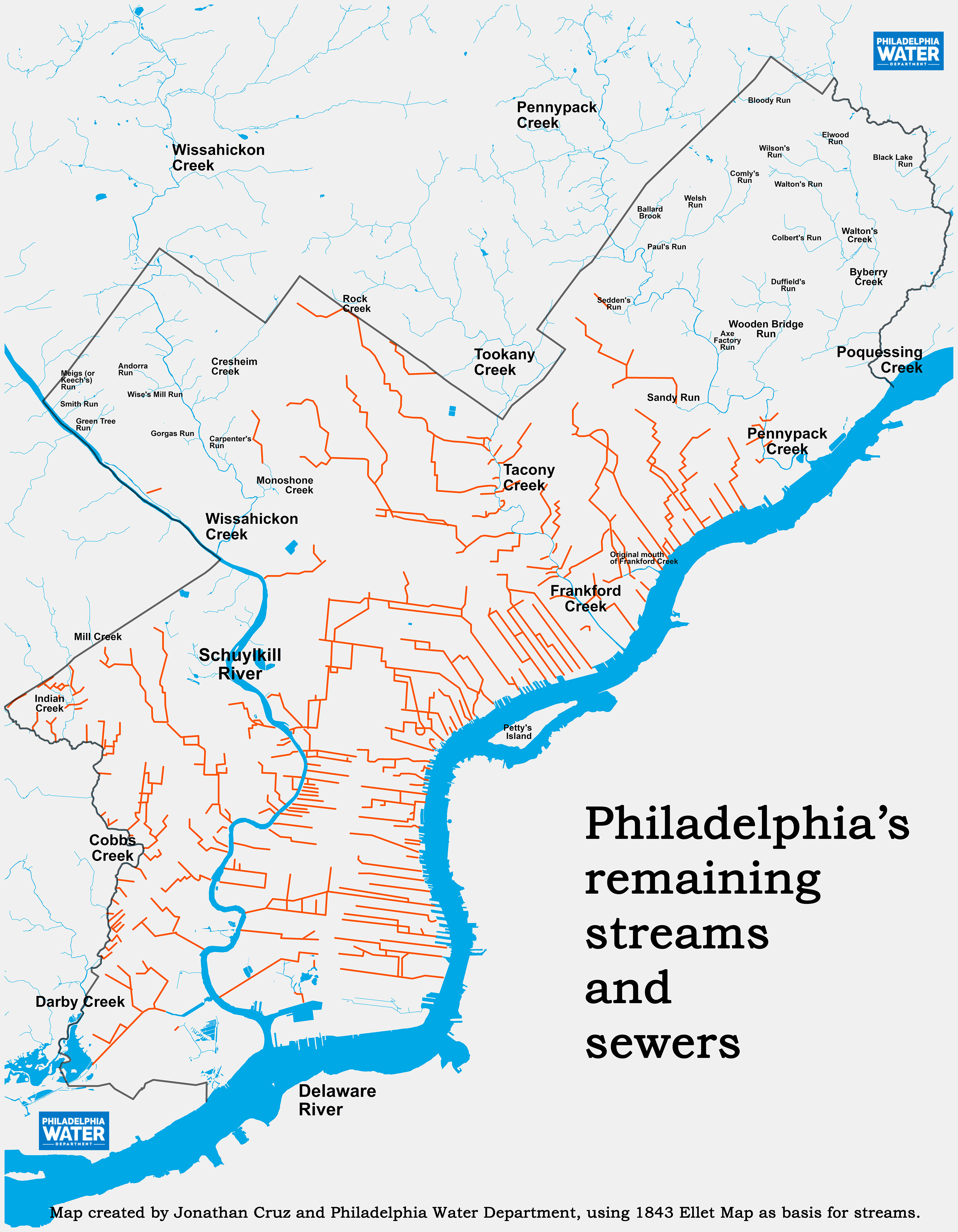This article, by Adam Levine, first appeared in Pennsylvania Legacies, v. 10, n.1 (May 2010), p. 14-19, published by the Historical Society of Pennsylvania.
For about 100 years, from roughly the mid-19th to the mid-20th century, Philadelphia poured raw sewage into its two major rivers, the Delaware and the Schuylkill, which also served as the sources of the city’s drinking water. Fouling one’s own nest is something that even a bird knows not to do. Yet, Philadelphia had good company in this seemingly irrational behavior, since many of the world’s most prosperous and populous cities did exactly the same thing.
Municipal water supplies tainted with sewage led to sickness or death for literally millions of people in these cities. This health disaster was mitigated in some places (such as New York and Boston) by piping in clean water from remote places and in others (such as Philadelphia and Pittsburgh) by building filtration plants to purify polluted river water. With the water made safe to drink, disease rates dropped dramatically, but any impetus to undertake the Herculean task of stemming water pollution at its myriad sources was lost.
Pollution became so severe in many places, including Philadelphia, that the rivers and lakes became dead zones, devoid of the dissolved oxygen needed to support aquatic life. Fish kills were common occurrences. Dockworkers were sickened by the fumes of hydrogen sulfide, a byproduct of the decomposition of sewage. The same fumes also tarnished the silver coins in sailors’ pockets and rusted any metal buildings along the riverfronts. Many cities and industries continued to use adjacent bodies of water as sinks for their wastes until federal mandates in the 1970s, including the Clean Water Act, forced them to do otherwise.
Much of the failure to develop proper methods of sewage disposal in the 19th century can be attributed to an adherence to a mistaken theory of disease. We now understand that many diseases are caused by microscopic bacteria, a number of which readily live in water and are easily transmitted through a polluted water supply. Before 19th-century scientists identified and isolated bacteria in various laboratories, other theories of disease held sway. The most prevalent was the “miasma,” or anti-contagionist,” theory, which claimed that disease was caused by bad odors, or “miasmas,” arising from rotting organic matter or other filth.
According to this theory’s proponents, these dangerous and deleterious odors could emanate from a variety of sources. The stench of coffee beans rotting on a wharf was one mistaken explanation for a 1793 yellow fever epidemic in Philadelphia that killed thousands of people; mosquitoes were the actual vector of transmission. The odor of naturally rotting organic matter in low-lying swamplands was also suspected of causing disease, which was one justification for draining and filling thousands of acres of tidal marshland in the city.
Human wastes were a ubiquitous source of miasmas, especially in densely populated urban centers. Before the introduction of the water closet, or flush toilet, human wastes were collected in privy pits, commonly located beneath backyard “outhouses.” These brick-lined pits usually had open bottoms that allowed the liquid components of wastes to drain into the surrounding soil. Even so, privies would gradually fill up and needed to be emptied periodically, a task regulated in 19th-century Philadelphia by the Board of Health. The board investigated complaints of foul-smelling or overflowing privies, requiring homeowners to empty them and fining those who refused to comply. They also licensed the privy cleaners, who often performed their nasty work at night when most residents were inside and thus less susceptible to the malodorous miasmas that such cleanings inevitably stirred up. The nocturnal nature of the work led to the creation of a nickname -“night men”- for those engaged in it and a common euphemism -“night soil”- for the material they handled.
In the first half of the 19th century, Philadelphia maintained several “poudrette pits” on the outskirts of the city into which the night men would dump casks of night soil they excavated from the privies. In these pits the wastes were mixed with charcoal and swamp muck, gypsum, or other materials that absorbed excess liquid and odors and encouraged their decomposition. The resulting “poudrette” (from the French for “powder”) was considered an agricultural fertilizer, and Board of Health records from this period indicate a number of sales of this human-based manure to farmers. After the Civil War, these wastes were generally disposed of in a simpler manner by diluting them with water and applying them directly to farmland or market gardens that still existed in rural areas of the city.
According to an 1886 U.S. Census report, Philadelphia issued about 9,000 privy cleaning permits in 1880, when about 20 licensed cleaners removed roughly 27,000 tons of waste. This figure included an estimated 22,000 tons of actual human “excreta” and, according to the report, “5,000 tons consisting largely of coal ashes and cinders, brickbats, broken dishes and glass, bottles, kitchen-utensils, boots, shoes, tin cans, cast-off wearing apparel, and, in fact, every imaginable thing which servants and others find it more convenient to hide in the privy-vault than to expose in the ash-barrel or to throw into the streets.”
As flush toilets became more popular after the Civil War, they were often connected to the household privy pit, which overtaxed the privy system. The toilets used several gallons of water per flush, while privies were designed to accommodate only directly deposited wastes containing far less fluid. Privies filled up more quickly and overflowed more often. The need for an alternative waste disposal system soon became clear. The common solution, used in Philadelphia and many other cities, was to connect households and businesses with underground sewers that quickly drained wastes from populated areas and dumped them in the nearest body of water. In Philadelphia, the receptacles of these wastes included not only the city’s drinking-water sources, the Delaware and Schuylkill, but also many smaller streams that were tributaries of those two rivers.

From a miasmist’s point of view, this solution seemed entirely reasonable: it got the dangerous, disease-causing stink out from under people’s noses, out of densely built neighborhoods, and into the rivers. If the theory had been right, public health would have improved. In reality, however, such a system of sewers, coupled with municipal drinking-water plants, proved to be an efficient delivery mechanism for bacteria and other disease-causing organisms. From the intestines of the sick, microbes were flushed into the sewers, dumped into the rivers, and then drawn into the reservoirs at the various pumping stations. To complete the deadly cycle, they were distributed in water pipes to households and businesses throughout the city.
From 35 miles of sewers in 1855, the Philadelphia sewer system had expanded to more than 1,000 miles by 1900. By then these sewers were emptying untreated wastes into the rivers and their tributaries at more than 100 discharge points, the largest of which was a pipe 20 feet in diameter. Between 1860, when the Board of Health began publishing detailed tabulations of causes of death, and 1909, when a city-built filtration system finally managed to supply the entire city with safe water, more than 27,000 people died of typhoid fever, the most prevalent of several deadly waterborne diseases carried in the drinking water. For each death, 10 to 15 others became ill, meaning that this disease ultimately affected hundreds of thousands of people in Philadelphia alone.
Besides facilitating the widespread pollution of the city’s rivers and streams, constructing this type of sewer system required a drastic remaking of the urban landscape. As urbanization expanded into undeveloped, rural sections of the city after the Civil War, the engineers who laid out these new neighborhoods decided to drain these areas by placing sewers in stream beds. The sewers carried the stream flow, any stormwater runoff from streets, and sewage from homes and businesses in a single large pipe. The engineers were not building sewers alongside the streams; they were subsuming the streams in their entirety into the city’s sewer system. Such a flagrant manipulation of nature for man’s purposes may seem unthinkable today, but it was standard practice in many cities well into the 20th century.
A number of practical reasons made the building of sewers in stream beds almost irresistibly appealing to municipal engineers. Sewage is 99.99 percent water, and like water, it flows most cheaply and efficiently when gravity does the work. The streams, of course, already flowed downward into either the Schuylkill or Delaware rivers. In addition, the moving water had already done much of the excavation work, having carved channels out of the landscape over eons-something that would have cost the city millions of dollars to do.
As engineers completed sewers and diverted the streams into them, they filled in the land over the pipes, sometimes 40 feet or more over the original stream bed. Once the fill had settled, the urban street grid could be extended across the valleys without the former expense of building a bridge at every stream crossing. The city installed water mains and gas mains under the streets, giving owners of the real estate through which the streams had run a readymade infrastructure for any new houses they built. Other than a small fee collected from adjacent property owners, the city paid for the majority of this sewer work. These expenditures were easily justified by the increased revenues that came from the transformation of barely taxed rural land into densely built urban neighborhoods. About 200 miles of Philadelphia streams were subsumed in this way.
Mill Creek once drained much of West Philadelphia, with its main branch running southeast from the aptly named Overbrook train station for five miles to the Schuylkill near 43rd Street. Sandy Run had its source near Fox Chase and ran for several miles; today only a small open section of the creek remains near its confluence with Pennypack Creek. Midvale Avenue in East Falls, Winston Road in Chestnut Hill, and Leverington Street in Manayunk all follow the former courses of small, unnamed streams. Thomas Run emptied into Cobb’s Creek, Wissinoming Creek and Gunner’s Run into the Delaware, Rock Run into Tacony Creek, and Little Tacony Creek into Frankford Creek. All now have gone underground and appear only on the city’s sewer plats.

For anyone who has ever been confused by the truncated creek that, on modern maps, changes names from Tacony Creek to Frankford Creek for no apparent reason, the missing piece of the puzzle is the Wingohocking Creek. In the city’s most extensive creek-to sewer transformation, more than 20 miles of streams in the Wingohocking Creek Valley were subsumed into the sewer system. Before this stream went underground, it joined the Tacony to form the Frankford near present-day I and Ramona streets in the city’s Juniata Park neighborhood-precisely where the name change on the map now occurs.
In some watersheds, it took many years to obliterate completely the main stream and its tributaries. The Mill Creek conversion from creek to sewer took nearly 30 years, and the Wingohocking project took almost 50 years. Early in the 20th century, city planners realized the benefits of creating parks in stream valleys, and many of the streams in Northeast Philadelphia, the last section of the city to be urbanized, remain open today as a result. Unfortunately, this change of heart on the part of the city’s designers came too late for most. The modern map of the city’s surface streams is now disturbingly blank.
Philadelphia and other major cities no longer grossly pollute their own waterways, but it took many decades to stem the flow of sewage. In 1905, the Pennsylvania legislature passed a law banning the discharge of sewage into state waters, and it required municipalities to submit plans for collecting and treating their wastes. Philadelphia’s plan, published in 1914, called for three sewage treatment plants and many miles of large pipes to capture the sewage before it reached the streams. The drinking-water filtration system, completed a few years earlier, was the city’s largest public works project up to that time, costing about $35 million. The sewage treatment system, when it was finally completed in the mid-1950s, set a new financial record, costing hundreds of millions of dollars.
Even with this system in place, the treatment processes removed only part of the solids and some of the bacteria from the sewage before dumping the effluent back into the Delaware River. [See note below.] Only with the Clean Water Act of 1972 were municipalities and industries held to higher standards, and only then did life begin to return to the rivers. With additional treatment processes added to the city’s three plants in the 1970s and 1980s, Philadelphia can now say that its sewage treatment effluent is cleaner than the raw water drawn out of the rivers at the drinking-water plants. This achievement is something in which the Philadelphia Water Department, as manager of the city’s sewage treatment and drinking-water systems, can justly take pride, but it was a long time coming.

Note from Debra McCarty, former PWD Deputy Commissioner, on the operation of the city’s three sewage treatment plants, Northeast, Southeast, and Southwest: “There is one minor correction that I’d like to offer for future reference. In the last paragraph you wrote that ‘the treatment processes removed only part of the solids and none of the bacteria.’ In fact, Northeast Plant was a secondary treatment plant in the 1950’s and thus removed a large percentage of bacteria/pollutants. The plant did not perform as well as it does today and after the expansion in the mid-1980’s but it did achieve a fairly high level of treatment. While Southwest & Southeast were only primary treatment plants, bacteria is removed in primary treatment, just not a large percentage (25-40% BOD). Again, I know this was in no way the point of the article, just felt I should set the ‘record’ straight.” (Source: Email from Debra McCarty to Adam Levine, July 27, 2010)
